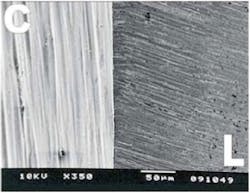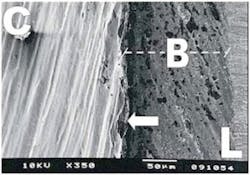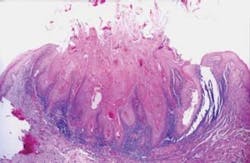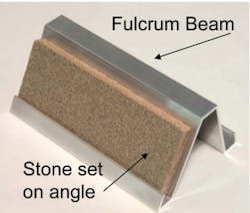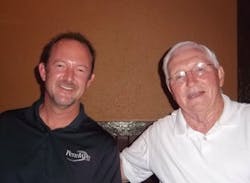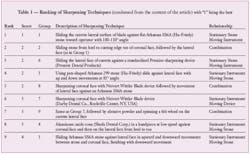The best method may come as a surprise
by Cynthia Biron Leiseca, RDH, EMT, MA
In recent years we have seen new equipment for sharpening instruments, but none of the research conducted has dramatically changed the way we sharpen instruments by hand. Is it simply because we have not looked closely at the most recent research? That may be the case, since a recent article from a scientific journal showed that there is a difference in the cutting edges of Gracey curettes when various sharpening techniques were used to resharpen dull curettes.Drs. Andrade Acevedo RA, Sampaio JEC, Shibli JA described the results of many different methods of sharpening. In their study, the instrument sharpening was completed by experienced clinicians. The results of their study were published in an article titled "Scanning Electron Microscope Assessment of Several Resharpening Techniques on the Cutting Edges of Gracey Curettes" in the Journal of Contemporary Dental Practice November; (8)7:070-077. Permission has been granted from the authors and editor of the journal to include the results of the study and the photos in Figures 1 and 2 for this article.
The study included nine groups, each using different sharpening techniques. Each group was scored according to the Cutting Edge Index developed for this study:
- Score 1: A precise angle of the coronal and lateral faces without wire edges.
- Score 2: A slightly irregular cutting angle with or without wire edges.
- Score 3: A markedly irregular cutting angle with or without wire edges.
- Score 4: An < cutting angle with a presence of a bevel or third surface.
The group whose technique produced the most precise cutting edge without wire edges and irregularities was Group 1: Stationary Stone, Moving Instrument (See Fig. 1).1
Yes, you read that correctly – that is NOT the technique most commonly used by dental hygienists. The most common technique is that which is taught in dental hygiene schools, Stationary Instrument, Moving Stone. It is the technique that was used by Group 3 of the study. Group 3 was not producing the perfect cutting edge; in fact, to quote the authors, "(Group 3) produced a high incidence of < cutting angles with the formation of bevels or third surfaces"1 (See Fig. 2).
The other techniques in the study were ranked and scored as shown in Table 1. The results shown in Table 1 indicate that most often the "Stationary Stone, Moving Instrument" relationship produced the most precise cutting edges with scores of 1 to 2.
Why is 'Stationary Instrument, Moving Stone' the most commonly used technique?
A well-conducted study is not necessary to answer this question. We do not need a step-by-step description of how to do this technique ... its internal angle of face to stone as 110°, etc. It is everywhere in every textbook and in every article on sharpening.
Fig. 1: Group 1 (Stationary Stone, Moving Instrument). By permission: Dr. Roberto Andrade AcevedoFig. 2: Group 3 (Stationary Instrument, Moving Stone). By permission: Dr. Roberto Andrade Acevedo
So to avoid being redundant, it is best to just get to the reason why it is a frequently used method for manual instrument sharpening, rather than revisiting the technique that could be parroted back by any hygienist.
The "Stationary Instrument, Moving Stone" technique provides the best view of the lateral face of the instrument against the stone. You can see the angle of the stone against the lateral side of the blade as you hold the instrument with your nondominant hand braced on a counter, and look at the angle of the stone as you move it around the curve of the blade with up and down strokes. That is the advantage to the technique; it allows you to see the blade against the stone. It does not, however, afford the best control of the stone for adapting to the blade since the stone is being held in midair without a fulcrum. And holding the instrument perfectly stationary is not possible by most clinicians. If you watch someone perform this technique, you will see that the instrument moves slightly (at best) with every movement of the stone.
Don't believe it? Get someone to videotape you doing it. If you can produce a video of "Stationary Instrument, Moving Stone" and the instrument doesn't move a single bit, you need to create a video and tell us how you turned your nondominant hand into a vice! (Those who have ownership of this technique, please lighten up and laugh.) A vice is what is required to hold the instrument absolutely stationary while you are stroking it with a stone from your dominant hand.
Fig. 3: The Sharpening Horse – allows clinician to perform Stationary Stone, Moving Instrument technique while using a fulcrum and seeing the blade against the stone.
If the instrument is not truly stationary, there will not be a precise cutting edge after sharpening the instrument. Case in point, this technique ranked and scored the worst in the study.1
Why is 'Stationary Stone, Moving Instrument' not a commonly used technique?
This technique requires the clinician to put his or her hand down on the stone and adjust the face-to-stone angle without having a bird's eye view of the face-to-stone relationship. Those with an acute tactile sense can actually feel the face of the blade against the stone. They can be quite accurate at adapting and moving the instrument from heel to toe using either a back and forth or sweeping motion. This is the technique Group 1 used in the study. Because the instrument is sharpened along the length of the blade, there are no wire edges such as those produced when moving the stone up and down against the cutting edge as Group 3 did with "Stationary Instrument, Moving Stone."
Understanding the design of the instrument's working end is crucial to proper instrument sharpening. Since Gracey curettes have an offset angle with a longer, lower cutting edge, the curvature of the blade is difficult to maintain when sharpening.
Therefore, if you can see the blade against the stone, it will increase the chances of maintaining the original shape of the blade.2
There are numerous brands of sharpening guides to help with the "Stationary Stone, Moving Instrument" technique. These guides are excellent for those who can perform the technique by tactile sensitivity without visual assurance of seeing the blade against the stone.2 None of the sharpening guides position the stone so that you can see the blade adapt to the stone when you are sharpening.3
A new fixture called The Sharpening Horse3, invented by the author of this article, is now available. It allows the clinician to see the blade adapted to the stone when using the "Stationary Stone, Moving Instrument" technique. It also allows the clinician to use a pen grasp and fulcrum while moving the instrument on the stone (See Figs. 3 and 4).
Why not just skip hand sharpening and stick to electronic automatic sharpeners?
Quite simply, you cannot sharpen contaminated instruments in electronic automatic sharpeners. And you should NOT sharpen contaminated instruments with the "Stationary Instrument, Moving Stone" technique because you are moving the stone with your dominant hand toward the tip of the instrument and there is an increased risk of getting an instrument stick in your dominant hand.4
You can, however, sharpen contaminated instruments with the "Stationary Stone, Moving Instrument" technique since neither hand is in the line of fire of the direction of the instrument's tip.4 This is another reason for mastering this technique.
After 15 strokes with the curette, the cutting edge has begun to dull.5 No matter how many instruments you have, it is easier to make a few swipes of the blade on the stone than to open additional sets of instruments when those you have been using during a procedure have become dull. And it is totally impractical to mount up triplicates of every type of scaling instrument on your tray so you can move on to another when two of one type become dull.
Conflicting studies exist regarding which brand of stone produces the most precise cutting edge, but the best outcome occurs when the clinician maintains the cutting edge with frequent sharpening with a fine stone.6,7 If sharpening is done after each use of an instrument, a finer stone can be used and less metal is removed. This helps maintain the original contours of the blade.
If sharpening is postponed until instruments are very dull, a coarser stone is required to restore the cutting edge. A coarser stone removes more metal, and the cutting edge will have irregularities from the larger abrasive particles in the coarse stone.6 Some research infers that an irregular cutting edge will cause minute defects in the root surface and the epithelial attachment.5,6
Ceramic stones have become very popular since they do not require oil as a lubricant. They may require water, but many can be used dry. It is a good idea to soak the ceramic stones in water prior to sharpening so that you can easily clean off the filings that accumulate during sharpening.
If your choice of instrument sharpening techniques is working for you, great! Continue to do it well and do it often, as in every time you use an instrument for a minimum of 15 strokes.
Sharp instruments are the greatest asset for periodontal debridement therapy.
Author's note: The Sharpening Horse is now a fundraiser for student members of the ADHA. Each school's chapter president should contact us at www.DHmethEd.com and click on "Student Services" to request the fundraising packet.
References1. Andrade Acevedo RA, Cézar Sampaio JE, Shibli JA. Scanning electron microscope assessment of several resharpening techniques on the cutting edges of Gracey curettes. J Contemp Dent Pract. Nov. 2007; 8(7):70-.2. Nield-Gehrig JS. Fundamentals of Periodontal Instrumentation and Advanced Root Instrumentation. 5th ed, Philadelphia: Lippincott Williams & Wilkins.
3. Leiseca CB. New Breakthrough in Instrument Sharpening. Dental Health Educators' Newsletter. July 2010; 1(3). www.dhmethed.com.
4. Miller CH, Palenik CJ. Instrument Processing. In: Miller CH, Palenik DJ, eds. Infection Control and Management of Hazardous Materials for the Dental Team, 4th ed St. Louis: Mosby: 2009:160.
5. Andrade Acevedo RA, Cardozo AKV, Sampaio JE. Scanning electron microscopic and profilometric study of different sharpening stones. Braz. Dent J 2006; 17(3):237-242.
6. Moses O, Tal H, Artzi Z, Sperling A, Zohar R, Nemcovsky CE. Scanning electron microscope evaluation of two methods of resharpening periodontal curets: a comparative study. J Periodontol. 2003; 74:1032-1037.
7. Huang CC, Tseng CC. Effect of different sharpening stones on periodontal curettes evaluated by scanning electron microscopy. J Formos Med Assoc. 1991; 90:782-787.


